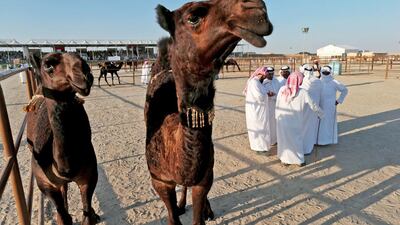At last, it's upon us: World Camel Day. This is our annual chance to celebrate these beautiful, unpredictable ungulates, who form such an important part of the landscape here in the UAE, whether wandering solitary in the desert, racing in front of thousands or competing in the camel beauty pageant at the Al Dhafra Camel Festival.
Even when we can't actually see a camel, they remain a part of UAE life, with millions of bottles of camel milk sold each year across the region.
Yes, if any animal deserves its own day, surely it's the camel. But how much do we actually know about these mysterious humped beasts? Okay, so you might have heard that they can survive without water for longer than most mammals (a camel can survive after losing 25 per cent of its body water, whereas most mammals keel over around the 15 per cent mark).
And you might already know that, contrary to popular opinion, the hump (or humps) isn’t for storing water – in fact, it’s where the excess fat, a camel’s source of energy, is located. Just in case you were wondering, a camel with one hump is known as a “dromedary”; those with two humps are called “Bactrian” camels.
But this sort of stuff is elementary. Read on if you really want to impress your friends with your knowledge of the camel. Here are 12 facts about the stars of World Camel Day.
(Oh, one last thing, Nouq Dubai, who make incredible camel milk ice cream are giving away pots of the stuff today (June 22) to celebrate World Camel Day. The first 300 orders on Deliveroo are free – get cracking.)
1. Camels originated in North America 45 million years ago. Despite the Middle East's long association with them, it actually took them quite a long time to get here. Around 3 to 5 million years ago, they crossed into Eurasia and eventually migrated south.
2. Camels can drink up to 40 gallons of water in one go – and they can go without water for two months. Apparently, one reason they can do so is because of the unique shape of their red blood cells: they're oval-shaped.
3. Camels can kick out in all four directions, using all four of their legs. So when you're approaching one, make sure you give it even more of a wide berth than you would say, a horse.
4. A camel was once used by Google to help map the Liwa Desert in Abu Dhabi. Raffia the 10-year-old camel became the first animal to aid in Google's mapping technology when the camel and her guide took to the dunes in 2014.
5. Camels can completely shut their nostrils during sandstorms. It stops sand from getting into their respiratory tract and causing them discomfort.
6. During the Second World War, German tank drivers would drive over camel dung in the for good luck – so the Allies made mines to look like camel dung. Not only that, but during the war, it also supposedly acted as a magic cure for dysentery. The secret, supposedly, was the bacteria in the camel dung, which helped digestion and evicted diseased bacteria.
7. Camels have three sets of eyelids and two rows of eyelashes to keep the sand out. The fuller than full set of lashes probably help in the beauty pageants, too.
8. Camels can travel at speeds of 40 miles per hour. This makes for some incredibly exciting scenes at the camel races, a favourite pastime of many in the Emirates and a highlight of the social calendar.
9. Camels are not born with a hump – it grows once the young camel starts easting solids. Also – when the animal eats the emergency food supply stored in its hump, the hump will shrink and fall to one side.
10. Camels only start sweating when temperatures reach 41 degrees. It's another reason why they can survive without water for so long.
11. Camel's milk contains less fat than cow's milk. Not only that, but it's healthier than bovine milk for many other reasons too: it has more powerful nutrients, improves the immune system, helps aid allergic reactions, and is more environment-friendly, as camels do not need the massive amount of grazing areas like other milk-producing animals.
12. Camels can live for up to 50 years. However, they only tend to live 20 to 40 years in captivity.




